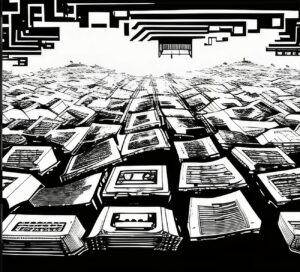Trouble in Paradise?
Labour Day should be a time of relaxation. Workers worldwide get much-needed recognition and a long weekend to rest and rejuvenate, a celebration of the hard work during the year. A time to forget about your work, your job goals, money, and investments. That is unless you work in the blockchain space. In that case, the weekend was slightly more tumultuous.
Over Labour Day weekend, the blockchain industry faced a couple of worrying events. Two of the largest networks in the space had severe unrelated issues and provided end-users with some unexpected experiences.
First, let’s discuss the less surprising but very strange occurrence on the Ethereum network.
Over the weekend, the Bored Ape Yacht Club began minting land parcels for its metaverse, titled Otherside. The push to the metaverse seemed like the logical next step for the project, on the outside. Their collections have maintained their status as blue-chip NFTs and have stood the test of time, at least in the crypto world’s definition of time.
The mint opened up to a massive number of participants, selling out 55,000 land parcels titled Otherdeeds for a whopping $317 million. This figure represents one of the largest NFT mints of all time, a genuinely groundbreaking figure. Besides the groundbreaking amount of cash collected by Yuga Labs during this drop, a separate, more worrying figure was also truly groundbreaking.
During the mint, data collected by Etherscan showed that for this particular project, users spent an estimated $183 million, or 64,700 Eth, on gas fees. Another truly astronomical figure. People hoping to mint this highly anticipated project began outbidding one another by paying higher gas fees to secure their NFT. At particular moments of the weekend, users were spending more significant amounts on gas fees than the cost of the NFT itself; some users reported paying up to $6,000 to mint pieces of the collection.
The trouble on the Ethereum blockchain over the weekend is problematic but not surprising. Much has been said of the lack of scalability that has plagued the Ethereum network. Each node, estimated to be around 300,000, must solve complex cryptographic problems to validate each transaction. As such, the network’s processing capabilities are, at times, unable to manage the demand. We won’t comment on the future because it is uncertain. Perhaps the shift towards proof of stake will solve the problems on the Ethereum network, but, at the moment, the end’s not near.
Ethereum scalability issues are nothing new. And, to be frank, neither are the problems that plagued the Solana network. We want to say what transpired over the Solana network this weekend is a first-time occurrence, but unfortunately, it is not. Over Labour Day weekend, the Solana network experienced its second significant and seventh overall downtime in 2022.
The Solana network received an astonishing number of transaction requests, as high as 4 million per second, initiated by bots from the Candy Machine NFT minting application. During this time, the network received almost 100 gigabits of data per second, adding to the network issues. The network was down for a total of seven hours. This figure may not sound so worrying to many outside the blockchain world, but we assure you that when almost $28 billion sits on a decentralized network, a lot is at stake.
During this time, Solana validators could not manage the sheer amount of transaction volume and network demands that the bots sent their way, forcing the validators to initiate a restart of the ecosystem collectively. The coordination of the validators should be applauded, and it is essential to note that Metaplex, a protocol for creating and minting NFTs on Solana, is introducing a botting penalty to prevent invalid transactions.
It is important to note that Solana is transparent about its network capabilities. The protocol claims to be able to process up to 50,000 transactions per second, with high levels of demand lowering this number into the thousands. 4 million transactions per second is a lot of traffic for any protocol to handle.
Currently, protocols do not need to process 4 million transactions per second. Comparing blockchain processing to the traditional world, Solana’s 50,000 transactions per second capabilities surpass the 1,700 transactions per second Visa processes.
The problem here lies not in the transaction capabilities, but in the network outage.
How do protocols work to ensure that the systems in place do not fail and collapse under large processing loads? It is perfectly acceptable to take slightly longer to process transactions under astronomical network demands, but what is not acceptable is users of a network being in the dark for several hours, especially when these users pledge large sums of capital to support the ecosystem. The goal is to create entire economies and ecosystems on public blockchains. If that goal is to come to fruit, reliability is a necessity. Public, and trustless ecosystems need to function under any network demands. No compromises.
Allow us to suggest a solution. Device side contribution to blockchain protocols for all end-users. Yes, it is slightly biased to suggest a solution that we have created. Nonetheless, it is a simple yet effective methodology to ensure consumers are never left in the dark and always have access to their assets. By allowing users to contribute and instantly generate a node in a blockchain ecosystem, there is created a failsafe protocol that ultimately protects against reliability concerns.
In NEST®, users can click to create a contributing node. Suppose all the primary nodes in the protocol were to fail under duress or enormous processing demands. In that case, the ecosystem remains active, as the device side contributions from users will ensure the ‘lights stay on’ while validators coordinate to rectify the problem.
At NEST®, we are not in the business of hitting someone when they’re down. This blog post is not supposed to attack the Ethereum or Solana protocols. Its purpose is to find and highlight a solution enabling us all to push the industry forward with innovative tech and solutions. Desktop or mobile contributions to confidentially secured DLT networks, from end-users, are a must. It is the only true way to protect our ecosystems and thrive as a collective. We just so happen to be the first people to do it.
Aman Deol
http://NES.TECH/





